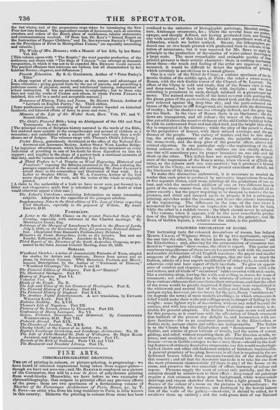FIRE ARTS.
CHROMALITHOGRAPHIC DRAWINGS.
THE art of printing in colours, or picture-printing, is progressing : we have heard of coloured impressions being taken from copper-plates- though we have not seen one ; and Mr. BAXTER is employed on a picture of the Coronation, that will be a tour de force of poly-chrome printing from wood-blocks. Meanwhile, we have before us two examples of Chromalithography, that surpass in pictorial effect any previous efforts of the press : these are two specimens of a forthcoming volume of Sketches of the Picturesque Architecture of Paris, Rouen, iST. by T. S. Boys—an artist who, from his long residence in Paris, is little known in this country. Hitherto the printing in colours from stone has been confined to the imitation of hieroglyphic paintings, Moorish architee. ture, Arabesque ornaments, &c.; where the several hues are positive opaque, and sharply defined, not having graduated tints, nor Mendip; 4 one with another : of this kind is Mr. JONES'S magnificent work of a; " Alhambra, which we before noticed. SHARP, the lithographer, pro: duced one or two heads printed with graduated tints in colours, in itai, tation of miniatures ; but it was reserved for Mr. Boys to apple the principle to the production of fac-similes of water-colour drawings% a large scale. The most remarkable and estimable quality of these printed pictures is their artistic character : there is nothing mechanical', about them—the touch and feeling of the artist are apparent ; and A.. mounted, it would be difficult to detect the operation of print' which certainly is not obvious to a casual glance. One is a view of the Hotel de Cluny, a curious specimen of the do. mestic Gothic of the middle ages, at Paris ; the other a street scene is Rouen, with the rich Gothic tower of the Church of St. Laurent. The effect of the Cluny is cold and crude, that of the Rouen view is warm and deep-toned; but both are bright with daylight; and the local colouring is prominent in each, though subdued to a picturesque har- mony. The stained stone walls of the hotel covered with posting bills the green gates of the porte-coeUre, the slated roof, and the red chimney. pots relieved against till deep blue sky, and the parti-coloured cot. tunics of the figures in HIE foreground, are imitated with the distinetnee of reality ; but the shadows are too strongly defined, and the gray tint; are too black. In the view of Rouen there is no blackness ; the she, dows are transparent, and all colour ; the tower of the church rises dim yetsolid above the massive richness of the old Gothic building before it, with its embrowned front and red-tiled roof, and the bright hlue of the sky is empurpled in the distance ; while the play of the pencil is shown in the perspective of houses, with their striped awnings, and the gay dresses of the people. The variety of texture and tint in this draw- ing, the aerial appearance of the clouds, the palpable substance of the stone-work, and the deep glow of the general effect, almost defy critical objection. In one particular only—the registering of the till- ferent colours—is it defective : the outlines are not clearly defined; one tint will sometimes pass its proper boundary on one side and fall short on the other. This defect does not materially injure the appear. ance of the impression of the RoutIn scene, when viewed at anttle tance, as the colours melt one into another ; but it produces a blurred outline in the Cluny, on account of its greater exactness of detail, and the blackness of the drawing.
To make this distinction understood, it is necessary to remind the reader that each print is produced by successive impressions from four or five separate stones, each stone printing all the gradations of one co• lour, and with the occasional addition of one or two different hues in parts of the stone remote from the leading colour : these should all re• gister exactly ; but the paper requiring to be damped to receive the im- pression, and dried and damped again to prepare it fur a subsequent printing, stretches under the pressure, and hence the minute inaccuracy of the registering. The difference in the tone of the two views is accounted for by one having an impression in black ink for its basis, while the other is a reddish brown : the black should never be adopted. The volume, when it appears, will be the most remarkable produc- tion of the lithographic press. HULLMANDEL is the printer ; and Mr, Boys, of Golden Square, a relative of the artist, is the publisher.


























 Previous page
Previous page